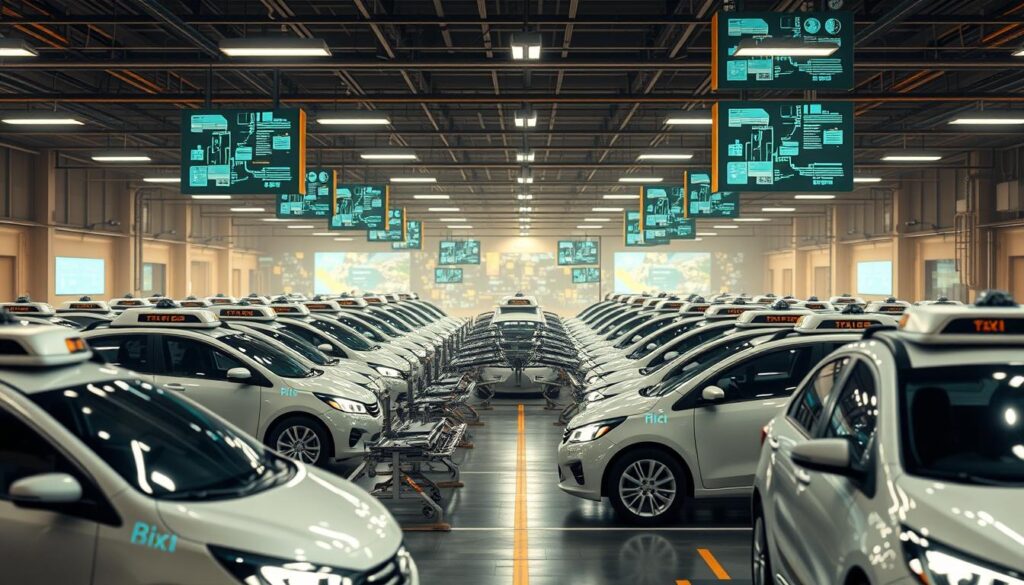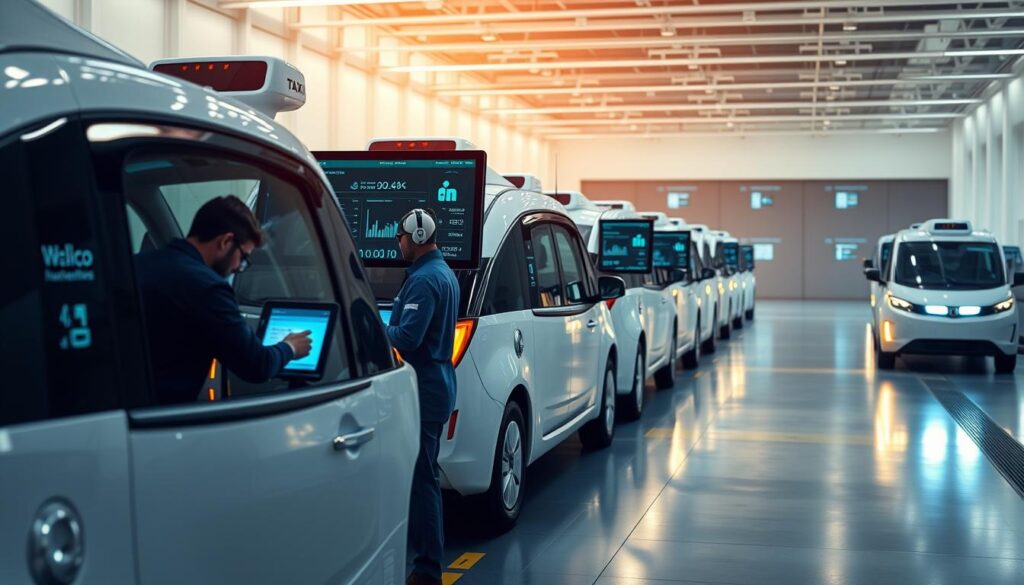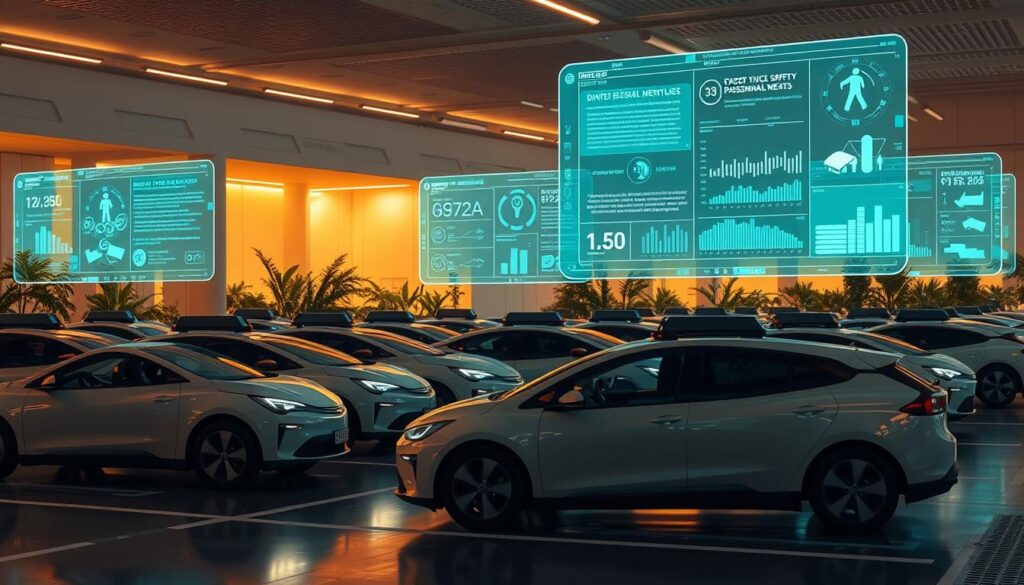On a rainy Thursday, an operations manager watched a map fill with delays. Vehicles stood idle in traffic, drivers lost hours, and fuel bills climbed. That single shift highlighted a simple truth: without real-time visibility, costs and downtime multiply fast.
Modern systems combine AI fleet tracking, IoT taxi monitoring, cloud analytics, and firmware updates to turn raw sensor data into clear actions. Together, these tools give managers instant vehicle health, location, and performance insights so teams can cut fuel use, reduce unplanned repairs, and boost safety.

This guide previews five solution categories—telematics and IoT platforms, computer-vision safety stacks, predictive maintenance suites, route optimization engines, and unified command centers. It explains how to pick technology, set KPIs, and measure total cost of ownership before scaling in dense U.S. cities where congestion and regulation raise the bar for uptime.
Key Takeaways
- Real-time visibility cuts costs tied to fuel and downtime.
- Integrated systems turn sensor data into actionable decisions.
- Five solution categories map to common operational needs.
- Managers must weigh KPIs and total cost before scaling.
- Safety, efficiency, and lower costs flow from better data use.
Why Autonomous Taxi Fleets Need AI and IoT Now
Mounting costs from fuel, congestion, and unplanned repairs are squeezing margins. Fuel represents nearly 30% of typical operating expenses, while congestion costs ~43 lost hours and $771 per driver each year.
Rising fuel costs, systemic traffic delays, and maintenance issues are the top cost centers for modern vehicle operations. Manual spreadsheets and static routing no longer cut it; they waste fuel and raise accident risk.

Rising fuel, traffic, and maintenance pressures
Real downtime from unplanned maintenance disrupts schedules and hurts revenue. Traffic patterns and weather make routing brittle when decisions are reactive.
From manual tracking to proactive operations
Real-time data pipelines feed models that enable predictive maintenance and dynamic route planning. Connected systems fuse traffic, road conditions, and pickup windows to cut idle time and delays.
- Safety dividend: early issue detection and driver behavior alerts reduce incidents.
- Manager benefits: live insights let managers resolve issues before they escalate, improving uptime.
- Quick wins: deploy telematics, enable continuous diagnostics, and pilot AI-assisted route planning to curb costs within weeks.
“Companies that embrace connected systems now will gain higher utilization, better adherence to service windows, and more predictable costs.”
Core Concepts for Autonomous Taxi Management
Driverless operations shift focus from seat-time to sensor-time, changing how teams run vehicles day to day. Remote supervision, higher sensor density, and continuous telemetry make oversight more like software ops than traditional dispatch.
How operations differ from traditional fleets
Remote operators replace some in-vehicle tasks. Vehicles stream GPS, speed, engine diagnostics, and sensor data nonstop. That continuous feed changes how managers set policy and safety rules.
Telematics, vision, and edge basics
The telematics stack combines GPS, accelerometers, and engine sensors to send real-time signals to systems used by managers. Computer vision uses cameras and LIDAR for 360° awareness, lane warnings, and incident capture.
Edge computing runs low-latency inference on-board so the vehicle can react before cloud round-trips complete. Cloud platforms then aggregate fleet-level data for performance analysis, model training, and maintenance planning.

Practical outcome: tighter diagnostics, over-the-air updates, and resilient route planning keep availability high in changing road and traffic conditions.
AI fleet tracking, IoT taxi monitoring, autonomous taxi management
Live operational visibility turns raw sensor feeds into immediate, actionable dispatch decisions.

Real-time visibility: location, status, and utilization for every vehicle
GPS position, engine diagnostics, and utilization metrics combine to give managers a live view of each vehicle. This single view prevents theft, tightens ETA estimates, and shows which assets need service.
Data pipelines: sensors, telematics, and cloud analytics working together
Sensor streams are normalized, enriched, and fed into cloud analytics. The result is clear insights and ranked dispatch priorities based on health, proximity, and demand.
From insights to automation: alerts, dispatch, and route adjustments
Real-time systems trigger alerts for maintenance thresholds, geofence breaches, and safety events. Dynamic route adjustments use traffic and weather to steer vehicles toward demand hotspots and reduce idle time.
- Integration with ADAS and video telematics adds context for incidents and improves claims handling.
- Automated reassignment smooths utilization peaks and boosts uptime, lowering fuel and maintenance costs.
- These solutions scale across regions while keeping responsiveness high for daily operations.
Predictive Maintenance to Reduce Downtime and Extend Vehicle Life
Using sensor history and live diagnostics, teams can spot failing parts before they cause a breakdown.
Predictive maintenance analyzes real-time diagnostics and historical patterns to forecast component failures. This lets operations schedule service during low-demand windows and keep availability high.

Using diagnostics and historical data to forecast failures
Models combine sensor trends, repair logs, and usage data to flag likely failures. Alerts surface issues in cooling, brakes, and battery health before they impair performance.
Scheduling service during planned windows to maximize availability
Planned service reduces emergency repairs and protects the customer experience. Pulling a vehicle at the right time also preserves routes and lowers fuel waste from unexpected downtime.
- Cost benefits: fewer roadside fixes, smarter parts inventory, and better technician utilization.
- Remote diagnostics: shorten time to resolution and enable preemptive parts ordering.
- Records and compliance: consistent maintenance logs improve resale value and lifecycle outcomes.
Practical steps for fleet managers: integrate alert feeds into existing work queues, set low-demand windows for service, and map alerts to parts and technician workflows. Small pilots that tie diagnostics to dispatch yield quick, measurable gains.
Safety, Monitoring, and Incident Prevention in Driverless Operations
Safety systems must spot risks before a minor event becomes a major incident on busy streets. In-cabin and outward vision combine with automated controls to lower collision risk and improve response times.

Computer vision for in-cabin and 360° external awareness
Computer vision detects more than 20 risky behaviors, sending instant in-cab alerts for distraction, drowsiness, and seatbelt violations. Outward cameras flag rolling stops, tailgating, and sudden lane changes to protect people on the road.
ADAS, fallback behaviors, and automated interventions
Advanced driver assistance systems provide anticipatory interventions and automated fallback actions. When conditions degrade, the vehicle can execute a safe pull‑over and alert support while logging over 1,000 metrics per second.
Real-time coaching, anomaly detection, and post-incident evidence
Real-time coaching corrects driver behavior immediately, lifting safety metrics in days. Anomaly detection surfaces emerging risks so managers can act before incidents escalate.
- High-quality video and metadata speed insurance claims and exoneration.
- Insights feed maintenance planning when sensors show issues that affect control or visibility.
- Integration with policies and continuous improvement builds a stronger safety culture across the fleet.
Route Optimization and Dispatching with Real-Time Data
Dynamic routing engines recalculate paths in seconds to meet tight pickup windows and reduce idle miles. These systems fuse live traffic, weather, and service windows so dispatchers can react before delays cascade.
Traffic-aware route planning adapts to current road speeds, incidents, and weather to reroute vehicles and protect ETAs. The shortest distance often costs more in fuel and time when congestion or poor road quality appears.
Traffic, weather, and delivery windows for dynamic replanning
Dynamic route planning uses live traffic feeds and weather data to meet service windows and avoid hazardous conditions.
When a road incident appears, the system recalculates and assigns the best nearby vehicle to reduce response time and idle miles.
Geospatial analytics to balance shortest time vs. lowest fuel consumption
Geospatial models weigh terrain, stop density, and traffic patterns to choose routes that cut fuel consumption and travel time.
Optimization balances time against fuel use so operators reduce empty repositioning and increase completed trips per shift.
- Dispatch logic assigns the nearest suitable vehicle to lower response time and idle mileage.
- Smoothed utilization reduces peaks and improves driver shifts and vehicle availability.
- Route adjustments respect maintenance windows and charging/refueling needs.
- Improved ETA accuracy boosts customer communication and predictability.
“Algorithmic routing has driven measurable reductions in travel time and fuel use for major parcel operators.”
| Metric | Before | After | Impact |
|---|---|---|---|
| Average travel time | 45 min | 34 min | -24% time |
| Fuel consumption | 8.5 mpg | 10.2 mpg | +20% efficiency |
| Idle miles per shift | 15 mi | 7 mi | -53% idle |
Fuel Efficiency and Cost Reduction Strategies
A data-first approach to route selection and driver behavior turns fuel into a predictable line item.
Minimizing idle time, harsh acceleration, and unnecessary distance cuts waste and extends component life. Reducing idling and hard braking lowers fuel use and limits wear on brakes and drivetrains.
Smart route design avoids congestion-prone corridors even when the distance grows slightly. That trade-off often improves overall efficiency and reduces stop‑and‑go consumption.
Automated fuel management and consumption analytics
Automated fuel management reconciles card transactions, telematics feeds, and route logs to expose anomalies. This process flags mismatches between gallons bought and expected consumption per trip.
Consumption analytics link terrain, congestion patterns, and speed profiles to benchmarks. Teams use those insights to set idling thresholds, speed rules, and exception alerts.
- Driver coaching on efficient driving lowers fuel and maintenance costs by cutting harsh events.
- Programmatic policies enforce idling limits and speed governance via in-vehicle prompts and back-end rules.
- Start with high-variance vehicles and drivers, then scale playbooks across the fleet.
Result: lower consumption, fewer repairs, and reduced emissions — delivering both cost savings and environmental benefit.
Technical Architecture: Building an AI-Enabled, IoT-Connected Robotaxi Fleet
A robust technical architecture ties in-vehicle processing to cloud analytics to keep operations responsive in dense cities.
Telematics, sensors, and edge compute
Start in the vehicle: telematics devices (GPS, fuel and engine health) pair with sensors for tire pressure and temperature. Edge computers run low-latency inference and buffer high-frequency telemetry when connectivity drops.
Cloud storage, ML orchestration, and data modeling
Secure transmission moves streams into cloud data lakes on AWS, Azure, or Google Cloud. Use MongoDB, Cassandra, or SQL for hot and cold tiers to handle telemetry, video, and event logs with low latency.
- MLOps deploys, monitors, and retrains models for predictive maintenance, route optimization, and anomaly detection.
- Observability and cost governance keep cloud spend aligned with performance goals and reduced fuel consumption.
Integration, APIs, and layered security
Middleware and REST/gRPC APIs bridge legacy dispatch, billing, and CRM tools to modern services. Emphasize layered security: encryption in motion and at rest, strong IAM, and continuous vulnerability scanning.
“Design for rugged hardware, network failover, and repeatable MLOps to sustain vehicle uptime in mixed urban conditions.”
Outcome: a resilient system that delivers scalable data management, secure operations, and measurable reductions in downtime.
Evaluating the Top 5 Fleet Monitoring Solutions for Autonomous Taxis
A clear evaluation framework helps managers pick solutions that deliver measurable operational wins. Focus on real-world tests that mirror peak traffic, varied routes, and mixed weather so results reflect true costs and benefits.
Must-have capabilities
Predictive maintenance must use diagnostics and historical data to predict failures before they occur.
ADAS and 360° vision should reduce incident rates and provide high-quality evidence for each event.
Real-time dispatch must react to traffic and weather and reassign vehicles to protect ETAs and efficiency.
Scalability, openness, and U.S. readiness
Prioritize open APIs, fast data export, and integration speed with existing fleet management tools. Verify U.S. compliance, data residency, and privacy controls for multi-region rollouts.
TCO, KPIs, and proof-of-value
Estimate costs across devices, cameras, connectivity (4G/5G), cloud storage, analytics, and support SLAs. Track KPIs: uptime, pickup adherence, fuel consumption, incident rate, and customer satisfaction.
- Evaluation factors: accuracy, latency, urban coverage, and resilience.
- Common issues: data quality and change management—vendors should provide onboarding and clear mitigation plans.
- Run a 90-day pilot with milestones, target metrics, and decision gates for scaling.
Conclusion
Operational leaders who combine real-time data with strong KPIs see faster improvements in uptime and cost control.
Connected technology, analytics, and automation lift fleet management by improving safety, efficiency, and costs across daily operations. Predictive analytics drives smarter maintenance and route optimization to cut downtime and consumption.
Managers should focus on data quality, KPI discipline, and continuous optimization cycles. Start with a pilot, measure on-time performance, incident reduction, and fuel consumption, then scale by proof of value.
Secure, resilient architectures and clear API integration keep systems compliant under varied conditions. Prioritize customer satisfaction as the north-star metric and move from insight to execution with tracking-driven workflows, maintenance rigor, and route-level optimization.
Assess vendors against must-have capabilities and total cost of ownership to choose solutions that fit company size, markets, and growth timelines.
FAQ
What are the top capabilities to look for in monitoring solutions for autonomous taxi operators?
Look for real-time vehicle location and status, predictive maintenance alerts, camera-based safety features, edge computing for low-latency decisions, and open APIs for integration. Prioritize solutions that combine telematics, diagnostics, and cloud analytics to give operators immediate visibility into vehicle health, utilization, and route performance.
Why do driverless fleets need machine learning and connected sensors now?
Rising fuel costs, congestion, and unplanned downtime make reactive operations expensive. Machine learning with connected sensors lets operators predict failures, optimize routes, and automate dispatch. This shift from manual tracking to proactive, data-driven operations reduces costs and improves availability and rider experience.
How does a driverless or tele-operated vehicle change fleet operational needs?
Without a human driver, management must focus more on remote supervision, sensor integrity, software updates, and redundancy. Emphasis moves toward health monitoring of compute units, camera and lidar systems, secure communications, and automated fallback behaviors to ensure safety and continuity.
What core technologies power robotaxi operations?
Key technologies include telematics for vehicle telemetry, computer vision for environment and in-cabin awareness, edge computing for fast decision-making, and cloud platforms for aggregation and model training. Together they create data pipelines that enable diagnostics, real-time alerts, and automated control.
How do predictive maintenance systems reduce downtime and extend vehicle life?
Predictive systems analyze diagnostics and historical patterns to forecast component failures before they occur. That lets operators schedule service in planned windows, replace parts proactively, and avoid costly breakdowns, increasing uptime and extending vehicle lifespans.
What safety measures are essential for monitoring driverless operations?
Essential measures include 360° external sensors and in-cabin cameras for anomaly detection, ADAS-style fallback behaviors, automated interventions when needed, and secure logging for post-incident evidence. Real-time coaching and anomaly alerts help maintain safe operations.
How does real-time data improve routing and dispatching?
Real-time feeds on traffic, weather, and vehicle status allow dynamic replanning to meet delivery windows and reduce delays. Geospatial analytics help balance fastest routes with lower energy use, while automated dispatching matches vehicles to demand efficiently.
What tactics reduce fuel consumption and operational costs for robotaxi fleets?
Reduce idle time, limit harsh acceleration and braking, and optimize routes to cut unnecessary miles. Automated fuel management and consumption analytics reveal trends and hotspots so managers can act on driver behavior and routing choices to lower costs.
What does a robust technical architecture for connected robotaxis include?
A robust architecture combines in-vehicle telematics and sensors, edge compute for latency-sensitive tasks, cloud storage and model orchestration for analytics, and secure APIs for integration with dispatch and maintenance tools. Cybersecurity and compliance are critical across all layers.
How should operators evaluate the top monitoring platforms for autonomous vehicles?
Evaluate platforms on predictive maintenance accuracy, camera and ADAS integration, real-time dispatch features, scalability, openness (APIs), and U.S. regulatory readiness. Calculate total cost of ownership—hardware, software, connectivity, and support—and require KPIs demonstrating efficiency, safety, customer satisfaction, and uptime.
Transform Your IoT Vision Into Reality.
Get free expert insights, architectures & cost breakdowns.
Drop your email to schedule free meeting.